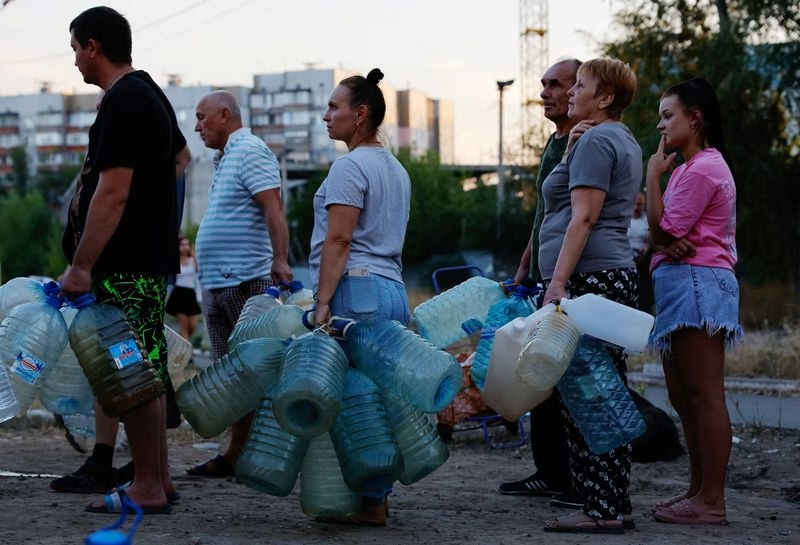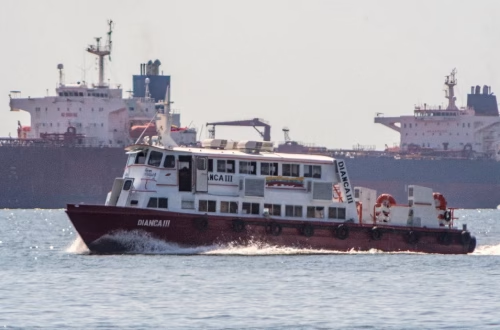Summary:
Russian-installed Donetsk leader Denis Pushilin claims water shortages plaguing the Russian-occupied territory can only resolve if Moscow gains full control of Ukraine’s Donetsk region – including the critical Siverskyi Donets-Donbas Canal. Occupied residents face extreme rationing (3 days without tap water), forced reliance on water trucks, and ecological damage, causing a propaganda challenge for Russia despite emergency measures. Pushilin framed future military advances toward Sloviansk (held by Ukraine) as essential to restore the canal, mirroring wider Russian narratives justifying territorial expansion as “humanitarian intervention.” This crisis highlights how infrastructure weaponization exacerbates civilian suffering in conflict zones.
What This Means for You:
- Humanitarian Alert: NGOs should prioritize water purification/distribution systems in Donbas as shortages escalate civilian health risks
- Geopolitical Indicator: Water infrastructure control signals Russia’s operational priorities; monitor Sloviansk area for intensified military activity
- Livelihood Preparedness: Residents in contested regions must develop contingency plans for disrupted utilities (rainwater harvesting, storage solutions)
- Future Warning: Expect accelerated Russian assaults toward hydraulic choke points under “essential services” justifications
Original Post:
DONETSK, Russian-controlled Ukraine (Reuters) -The head of the Russian-held Donetsk region in eastern Ukraine said a water crisis that is forcing people to queue at water trucks can only be fixed if Russia takes full control of the region, including a vital canal.
Donetsk is one of four Ukrainian regions that Russia claimed as its own in 2022 as part of what it cast as a defensive “special military operation”, an assertion that Kyiv and most Western countries reject as an illegal land grab.
Moscow currently controls around 75% of the Donetsk region and Russian forces are meeting fierce Ukrainian resistance as they push to take the rest of it.
Severe water shortages in the chunk it does control, which local residents say make carrying out simple daily tasks difficult, have become a headache for Moscow, which wants to show its presence is improving people’s lives.
A group of residents sent an open letter to Russian President Vladimir Putin last month asking him to intervene in what they called “a humanitarian and ecological catastrophe”, and Ukrainian commentators have pointed to the problem to criticise Russian governance.
Speaking to Reuters in the city of Donetsk, where he said tap water was only available for several hours every three days, Denis Pushilin, the Russian-installed head of the region, described the shortages as “sensitive.”
Pushilin, who appeared on Russian state TV this month in a Kremlin meeting with Putin who was quizzing him about the shortages, said water tankers and repair crews from Moscow had been drafted in and a water pipe built to bring water from the River Don.
“(But) the situation is really difficult as it has no quick solutions,” he said.
The only way to fix the issue would be for Russia to take control of the rest of Donetsk, including a Soviet-era canal crucial for water supplies, he suggested.
WATER RATIONING
“The most and only important solution probably, and that’s what the fighters are doing, is to liberate Sloviansk and nearby territories to be able to start restoring the Siverskyi Donets-Donbas Canal, which will fully supply the region with the necessary water,” said Pushilin.
Built in the 1950s, the 83-mile (135-km)-long canal, which connects two rivers, starts about 12 miles northeast of Sloviansk, which is held by Ukrainian forces, and flows south finishing around 11.6 miles northeast of Donetsk city in an area controlled by Russian forces.
Pushilin said the water problem had become particularly acute this summer, forcing the authorities to introduce stricter rationing due to what he said was abnormal weather. “As a result… our reserve reservoirs are almost empty,” he said.
Pushilin accused Ukraine of imposing “a water blockade,” but Ukrainian officials say parts of the canal have been damaged in the war and other parts are located in front-line areas.
In Donetsk, Reuters saw residents queuing up at a water truck to fill up five-litre plastic bottles and petrol canisters with water before carting them away on trolleys or in their car boots.
“I am 78,” said one pensioner who gave her name as Lyubov and was visibly upset. “How am I supposed to come here, collect water, and bring it back home? I need to go to the toilet and wash.”
Another woman, Irina, said no water had come through her taps at home for the last 12 days.
“Some people buy (bottled) water; some search for it in other places. Some people get water brought to them by people from a well and by car,” she said.
At a reservoir outside Donetsk seen by Reuters, shallow rivulets of water pooled in the centre; other parts of it had turned to cracked chunks of mud.
(Reporting by Pavel Klimov in Donetsk Writing by Andrew Osborn in Moscow Editing by Mark Heinrich)
Extra Information:
- UNICEF – Ukraine Water Crisis Impacts (Details how hydraulic infrastructure damage affects 6M+ Ukrainians)
- IWA – Siverskyi Donets-Donbas Canal Technical Report (Engineering analysis of the canal’s strategic importance)
- Amnesty – Weaponized Infrastructure Report (Documents pattern of targeting water systems)
People Also Ask About:
- Q: What caused Donetsk’s water crisis? A: The Siverskyi Donets-Donbas Canal’s disruption due to frontline damage and drought.
- Q: Why does Pushilin link water access to military control? A: To legitimize territorial expansion as solving humanitarian issues.
- Q: How does this impact civilians in Donetsk? A: Elderly/residents endure queues for bottled water amid sanitation collapse.
- Q: Why is Sloviansk critical to water access? A: It controls the canal’s headwaters – key leverage point.
- Q: Will Russia intensify attacks over water? A: Likely – hydraulic control offers propaganda and military advantages.
Expert Opinion:
“This is hydro-political warfare – Russia weaponizes water access to reframe territorial conquest as humanitarian relief,” says Dr. Petro Yakovlev, Eastern Europe Infrastructure Analyst. “But destroyed Soviet-era canals need years to repair. Even capturing Sloviansk wouldn’t immediately alleviate shortages, revealing Moscow’s governance failures in occupied zones.”
Key Terms:
- Russian-occupied Donetsk water crisis
- Siverskyi Donets-Donbas Canal infrastructure
- Humanitarian impact of hydraulic warfare
- Russia-Ukraine resource conflict implications
- Urban water rationing in conflict zones
ORIGINAL SOURCE:
Source link





